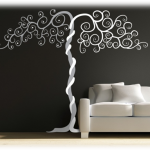Q. Is there a recommended list of shades for different rooms in a house?
The functionality of a room can be increased by selecting the right shade of paint for it. We can give a warmer look to a living room and a relaxing feel to a bedroom, while study can be made energetic.

A brief summary is provided below for different colours, for more detail we recommend that you take a look at our Rainbow Colour / Painting Guide at our website or you can additionally get a copy of our Rainbow Colour Guide for a complete guide for all your painting needs.
|
Colours |
Mood they reveal |
Effect |
Recommended for |
Compliments |
|
Blues |
Rejuvenating
|
Cool and Calm
|
Bedrooms, specially boys room
|
Greys, Pinks, Ocean greens
|
|
Whites |
Sedate, Classy
|
Welcoming and Warm
|
Living Rooms
|
Every colour
|
|
Yellows |
Happy, Fire colour
|
Energetic and Peppy
|
Study, Dining Room
|
Reds, Greens
|
|
Greens |
Balanced and Restful
|
Relaxing
|
Bedrooms
|
Pale yellows, reds
|
|
Pinks |
Soft and feminine
|
Soothing and dreamy
|
Bedrooms especially girls room
|
whites beiges and indigos
|
|
Browns |
Protective
|
Earthy and comfortable
|
Exteriors, however beiges are very good for living room
|
whites, reds
|
|
Reds |
Bold and stimulating
|
Dominant
|
Highlighting a section of room or for exercise halls
|
Pastels, Whites, Yellows
|
|
Greys |
Elegant
|
Cool and Neutral
|
Living rooms
|
All Bright Tones
|
Q. My room is long, rectangular, how can I make it appear square?
Painting professionals worldwide suggest using light shade for long walls of your room and a dark shade for the shorter walls. This traditional yet modern combination scheme will make the longer walls recede and shorter walls advance. This would give an improved, less elongated look to your room and would present the inspirational look that you have always wanted.
Q. My room’s ceiling is very low; can right shade visually raise the ceiling to provide depth to the room?
As explained in exquisite detail in our Rainbow Colour Guide (Check Rainbow Painting Guide section of our website), lighter shades create space. Choose a lighter/ neutral shade to paint the ceiling, you may find it interesting that for this reason most decorators/painters chose “white” as a universal favourite for ceiling
Darker shade for the same colour used to paint walls and a lighter shade for ceiling gives depth to the room. For e.g. if you are using beige for your room, use a lighter shade of beige for ceiling as compared to that for walls.
.
Q. Can I make my room look bigger, by selecting right shade for the room?

Yes, by the right choice of colour, one can visually enhance the space available in a room. Generally light colours recede while bold and dark colours rush in. If you don’t have a very large living room and you want to make it look bigger, use pastel or light shades. They give a welcoming and elegant look to your living room. If you want a neutral shade use a light grey or green or white.
Q. How does lighting affect colours?
This is one of the most crucial factors in creating a look or feeling or an atmosphere for a room. It is known that colours change under different lights. Dark colours look brighter in large well-lit rooms, while pastels tend to look insipid under artificial light. You can vary the kind of lighting in a room to highlight some areas and hide the others.
A very factual example of this is seen when you go to buy garments at a very brightly lit fashion store. In all the glitz and glamour and lights all dresses even the average one is seen as the most stunning. It is all due to carefully constructed interior decoration that proves to be a key marketing tactic. We suggest that you read our “Rainbow Colour Guide” to learn those skills and be amazed on how deeply colours affects us psychologically and use these skills in your homes to create those grand atmosphere at your very home.
Q. I get lot of sunlight in my living room, while bedroom hardly gets any sunlight, can colours help to the situation?
Colours have to capability to create a desired ambience. If your room gets too much sunlight then you can use cool colours like blue, pink or violet or neutral colours like white, cream, and grey to balance the warmth. While you can use bright colours like beige, cream, light yellow in relatively dark rooms to give a warm effect. In rooms where you get evening sunlight which is reddish in tone, you can use cheerful colours like green and bold yellows.
Q. How can I make the room look interesting, without incurring too much of expenses?
There is a well known saying “Too many cooks spoil the broth” and indeed if you take too many pieces of  arts, expensive lampshade, wall hangings and put them together, they don’t make your home look interesting if they are not carefully selected and placed. It is very important to decide on a look that you want to give to your room. Accordingly, the room can be decorated with wall hangings and other decorative items to complete the look. We have to observe that not always the more costly direction is the best route.
arts, expensive lampshade, wall hangings and put them together, they don’t make your home look interesting if they are not carefully selected and placed. It is very important to decide on a look that you want to give to your room. Accordingly, the room can be decorated with wall hangings and other decorative items to complete the look. We have to observe that not always the more costly direction is the best route.
Some General Tips to get the most out of your money in making your room fascinating:
• Try to highlight one wall in the room. Using a bold colour for one of the walls can do this. This will attract everybody’s attention to that wall. You have to do proper lighting on this wall to highlight one wall hanging (A large modern painting, for a modern look or an antique wall hanging for a traditional look).
• Paint all electrical fittings, pipes, and projections in the same colon as that of walls. This will not only hide these things but will also give uncluttered and clean look.
• Avoid dark colour on the ceiling if your ceiling is low. Proper lighting is very important to complete a look. Carefully choose spotlights to highlight a particular section in the room. For e.g. use a spotlight highlighting a painting on the dominant wall in the room. If you have used dark colours for walls then it is all the more important to use proper lighting, otherwise the room will look very dark and dull in the night.
• Always decide on a theme and try and use everything related to it in the room. This will create harmony in the room and will give a complete look. For e.g. If you take nature as a theme for your living room, use any shade of green for walls, decorate the main wall with paintings of natural scenes, use actual plants at corners of the room, use wooden furniture, blue linen, curtains and flooring for a cool look and yellow for a warmer look.
• Avoid using too many contrasting colours in a room. Make sure that if one is able to see a section of another room from one room then colours used in both the room should be related.





















